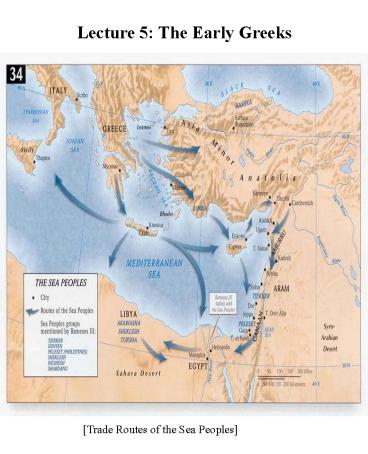Trade Routes of the Sea Peoples - PowerPoint PPT Presentation
1 / 25
Title:
Trade Routes of the Sea Peoples
Description:
Used hieroglyphic script (Linear B) which may be Egyptian since Minoans traded with Egyptians ... king) visited the gods every 9th year may have. inferred ... – PowerPoint PPT presentation
Number of Views:229
Avg rating:3.0/5.0
Title: Trade Routes of the Sea Peoples
1
Lecture 5 The Early Greeks
Trade Routes of the Sea Peoples
2
-- Greek history began around 2000 BCE
and reached its height around 400 BCE -- Greeks
were Indo-Europeans who originated in central
Europe and moved into southern and eastern
Europe, India, Iran, Asia Minor, and the
Mediterranean -- Until 1870 CE prehistory of
Greeks known only through legends and epic
poetry (Homer Iliad and Odyssey) -- Archeologis
ts Arthur Evans and Heinrich Schliemann discover
Troy and Mycenae 1952 Michael Ventris discovers
Linear B -- Early Greek culture was Minoan
(Cretan) -- Minoans form a cultural bridge
between Mideast and mainland Greece
(Peloponnese) -- Minoan society begins around
3000 BCE with Neolithic immigrants from Asia
Minor
3
-- Minoans used bronze, cement stucco,
bought copper from Cyprus, rich in grain, wine
and cypress -- By 2000 BCE cities clustered
around palaces at Knossos (near modern capital
of Heraklion) and Phaestos -- Used hieroglyphic
script (Linear B) which may be Egyptian since
Minoans traded with Egyptians -- Minoans were
secure, pleasure-loving, loved sports,
festivals, art, nature -- Minoans had a mother
goddess who personified abundance believed that
Minos (ancient god/ king) visited the gods every
9th year may have inferred succession cycle
for kings) -- Around 1500 BCE, earthquake
destroyed Knossos mainland Greeks then
invade -- Greek warriors introduce horse and
chariot warfare to Crete by 1400 conquer the
Minoans
4
Minoan Kamares Style Beaker Jug from Middle
Period c. 1800 BCE
5
Late Minoan Style Octopus Vase (c. 1500 BCE)
6
Minoan Snake Goddess, Gold/Ivory, c. 1600 BCE
7
Minoan Sphinx, Molded Clay, c. 2100-1500 BCE
8
Minoan Aerial View of Palace of King
Minos at Knossos,
c. 1500 BCE
9
Minoan Porch from Palace of King Minos,
Knossos, c. 1500 BCE
10
Minoan Palace at of King Minos at Knossos
Queens Megaron, c. 1500 BCE
11
Enlargement of Dolphin Frescoes, c. 1500 BCE
12
-- Origins of Achaeans (mainland Greeks)
unknown by 1950 BCE Greek peninsula invaded by
Greek-speaking tribes who rode horses and
produced distinctive pottery -- Between 16th and
13th centuries BCE Achaean chieftains dominated
the Greek mainland dominated by Mycenaean
kings -- By 1100 BCE Mycenaean civilization
in decline, possibly because of invasion
by other Greek-speaking tribes from the north,
the Dorians -- Little known about the Dorians,
so that period between 1100 750 BCE known as
Dorian Dark Ages -- After invasion by Dorians,
other Greeks from north and central Europe
occupy Asia Minor (Ionia or modern Turkey) and
Aegean islands -- By 8th century, Greeks adopt
Phoenician alphabet, epic poetry appears
13
-- 8th century Greek culture based on
agriculture, society controlled by landed
warrior aristocracy in which kings are first
among equals -- Between 750 500 BCE Greeks
colonize the Mediterranean and Black Seas polis
(city- state) becomes the central institution of
Greek life -- Polis included central meeting
point (Acropolis in Athens), frequently walled,
an open agora (assembly and market
place) -- Poleis could be only a few square
miles to a few hundred square miles, or could be
conglomeration of several smaller
poleis -- Adult males were citizens with full
political rights, women and children were
citizens with no political rights, slaves and
resident aliens were non-citizens
14
Mycenaean Warrior Krater, c. 1200 BCE
15
Enlargement of Warrior Krater
16
Mycenaean Family Group in Ivory
17
Mycenaean Terracotta Goddess
18
Mycenaean Orpheus Fresco from throne Room
of Palace of Nestor at Pylos
19
Fragment of fresco from Palace at Tiryns
Procession of Women
20
Reconstruction of Megaron at Pylos
21
Aerial view of Citadel of Mycenae
22
Lions Gate entrance to Mycenae
23
Entrance to the Tomb of Atreus
24
Beehive Ceiling from Tomb of Atreus
25
Gold Funerary Mask Found in Grave Shaft (Mycenae)































